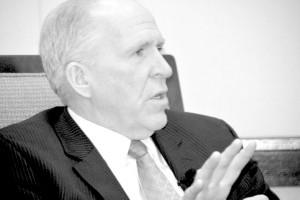CIA turns to HBCUs to help diversify the agency
23rd November 2015 · 0 Comments
By George E. Curry
Contributing Writer
WASHINGTON (Special from George Curry Media) — After commissioning a report highly critical of the Central Intelligence Agency’s efforts to diversify its staff and senior leadership, CIA Director John O. Brennan is reaching out to Black colleges to develop a more representative workforce.
Brennan and Johnny C. Taylor, Jr., president and CEO of the Thurgood Marshall College Fund, held a news conference Friday to announce a partnership to increase the presence of African Americans throughout the ranks of the CIA.
Brennan, who was sworn in as director of the CIA on March 8, 2013, appointed a special commission headed by former National Urban League President Vernon E. Jordan, Jr. to study the agency’s shortcomings in diversity and to make a series of recommendations.
“He came out with a very frank and candid assessment of the problems that we have in terms of the way we recruit, develop, train as well as groom individuals in order to assume those positions of leadership in the agency,” Brennan said, referring to Jordan.
As a result of the report, Brennan said, “We have a very, very rigorous effort to make sure that we are able to address those issues that were raised in that study and hold ourselves into account.”
Taylor said under the partnership, the Thurgood Marshall Fund’s 47 publicly-supported Historically Black Colleges and Universities (HBCUs) will serve as a pipeline for the top federal agency that manages intelligence collection, analysis, covert action, counterintelligence and serves as a liaison to foreign intelligence services.
“What the Thurgood Marshall College Fund is saying is there are really talented students at institutions other than Harvard, Yale and the (military) academies. There is Howard, Fort Valley State, Florida A&M University – schools that you never though about are chocked full of talent… How we’re going to help the CIA with this national issue is we’re going to provide them with access to these students.”
Taylor praised Brennan for having the “courage” to make the CIA study public and, more important, implementing a plan to address the issues raised in the Jordon study, formally called the “Director’s Diversity in Leadership Study: Overcoming Barriers to Advancement.”
Diversity is generally defined as any characteristic that makes one individual different from another. The federal Office of Personnel Management listed those characteristics as race, ethnicity, gender, disability, sexual orientation and gender identity.
The 48-page report noted that in 2006, former CIA Director Michael Hayden observed, “A lack of diversity of thought and experience was identified by congressional committees and independent commissions as contributing to past intelligence failures. That diversity is mission-critical is no longer a debatable proposition – if it ever was. The business case for diversity has been made, and just as private industry is responding to affect their bottom line, we must respond appropriately to drive mission success.”
According to the report, at least four previous directors – Leon Panetta, Michael Hayden, George Tenet and Porter Goss – have lauded the importance of diversity – without any significant improvement.
“Despite the findings of numerous prior studies…the record clearly suggests that the senior leadership of the Agency is not committed to diversity. The fact is there has been little progress over the past several decades in diversifying the leadership cadre and pipeline and in sustaining the hiring of diverse officers.”
With a few notable exceptions, the report stated, the most senior positions in the CIA are “consistently occupied by white male career officers.” It declared, “In fact, the more senior the Agency’s workforce is, the less diverse it is.”
In some instances, there has even been retrenchment.
“While an increasing proportion of African-American officers were promoted to SIS [Senior Intelligence Service] from 1984-2004, the effect of that progress has reversed in the past 10 years,” the study found.
There are problems in the lower ranks as well.
The report stated, “Though the Recruitment Center may have pursued diversity recruiting strategies for many years, these efforts have been ineffective.”
According to the report, “Since 2008 the percentage of minorities hired has declined to levels lower than what is necessary to sustain the level of minority representation in the current workforce. Building and sustaining a diverse pipeline will not be possible without improved results in recruiting officers from all segments of American society.”
Citing what it described as “the dramatic gap between the composition of the workforce and the leadership ranks,” the study found that racial and ethnic minority officers make up 23.9 percent of the CIA workforce, but only 10.8 percent of the Senior Intelligence Service (SIS), 15.2 percent of GS-15s, and 21 percent of GS-14s.
On the other hand, White women have moved into the top ranks at a faster rate than Black men or women, according to the report. White women “are approaching parity with their representation in the overall workforce,” the study said. “However, minority officers, particularly women of color, have not experienced similar gains.”
Director Brennan said he is determined to change that picture.
In the past, he said, various factors account for the poor representation of people of color in the agency, including the agency focusing on terrorism around the world while paying insufficient attention to internal personnel issues.
He said as part of senior management’s regular assessments, diversity will also be a regular yardstick.
“As I’ve mentioned, we’re so focused on mission – everybody is always working on substantive issues,” he explained. “I expect them to be able to spend some of their time — a significant amount of their time — addressing these issues of the workplace and what we need to do to develop leadership.”
This article originally published in the November 23, 2015 print edition of The Louisiana Weekly newspaper.




